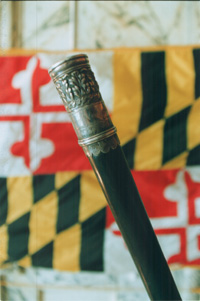![]()

Photograph courtesy of Tom Darden
![]()

Photograph courtesy of Tom Darden
A symbol of the independence and authority of the House, the mace is used to bring order to the House of Delegates and to summon witnesses before it. In Maryland, the first mace was presented on March 10, 1698 by Governor Francis Nicholson to Thomas Smithson, Speaker of the House of Delegates (then known as the Lower House of Assembly). Although it is not known for certain, the present mace may be the original. Today, it is placed in a wooden holder on the lower rostrum of the House chamber to signify when the House of Delegates is in session.
The House of Delegates' mace is a single wooden rod, 24 1/2" long and 1 3/4" in diameter. It may be made of ebony, or possibly oak, stained to look like ebony. It may be made of ebony, or possibly oak, stained to look like ebony. It is capped with silver on which is engraved the 1794 Great Seal, designed by Charles Willson Peale, a native Marylander and one of the foremost artists of his day. The motto, "Industry the Means, Plenty the Result," was the official state motto from 1794 until 1817. Although there is no surviving record to explain why the House chose to have the 1794 great seal engraved on its Mace, we do know that Peale's Seal was executed on commission from the State at a time of great national State pride.
The Mace was chosen as The Speaker's Society's logo because
it is the oldest and most venerable object in the House's possession and
because, more than any other symbol, it stands for the orderly, deliberative
process of representative government of the people, by the people, and
for the people.
![]()
|
Tell Us What You Think About the Maryland State Archives Website!
|